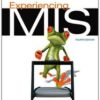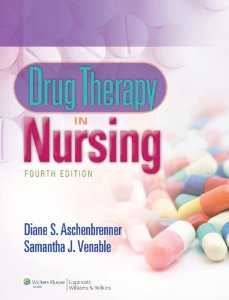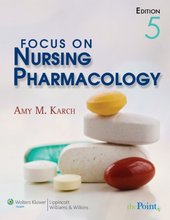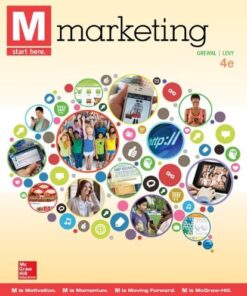Test bank Drug Therapy 4th Edition Aschenbrenner
$35.00
Test bank Drug Therapy 4th Edition Aschenbrenner
Success in nursing school is truly a journey. Spend less time learning worthless information and more time memorizing what you need to know. Our nursing test banks for sale are proven to generate results, regardless of your education level or any previous failures you may have experienced. Add this product to your cart and checkout to download this TEST BANK DRUG THERAPY 4TH EDITION ASCHENBRENNER .
*** BELOW, IS A SAMPLE FROM THIS NURSING TEST BANK, YOU WILL RECEIVE THE CHAPTERS VIA PDF OR WORD DOCUMENT ***
CHAPTER 2
1. A physician has ordered subcutaneous injections of morphine, a narcotic, every 4 hours as needed for pain for a motor vehicle accident victim. The nurse is aware that there is a high abuse potential for this drug and that it is categorized as a
A) C-I drug.
B) C-II drug.
C) C-III drug.
D) C-IV drug.
Ans: B
Feedback:
Narcotics such as morphine are considered C-II drugs because of the high abuse potential with severe dependence liability. C-I drugs have high abuse potential and are not accepted for medical use. C-III drugs have a lesser abuse potential than C-II drugs and an accepted medical use. C-IV drugs have a low abuse potential and limited dependence liability.
2. A nurse working for a drug company is involved in phase III drug evaluation studies. Which of the following might the nurse be responsible for during this stage of drug development?
A) Working with animals who are given experimental drugs
B) Monitoring drug effects in patients who are selected to participate in a study, who have the disease that the drug is meant to treat
C) Administering investigational drugs to patients
D) Informing healthy, young volunteer participants of possible risks that could occur from taking an experimental drug
Ans: C
Feedback:
Phase III studies involve administering investigational drugs to patients in a vast clinical market who are voluntarily enrolled in double-blind studies. In phase I studies, a small number of healthy human volunteers are given the drug after blood urine and other appropriate samples are taken to monitor drug metabolism. Sometimes volunteers who have a certain disease are used in phase I instead of healthy volunteers if the drug is expected to have significant toxicity. In phase II, volunteers are given various dosages of the test compound and studied in great detail. Dosage guidelines are usually determined in this phase. Nurses are more likely to be responsible for administering the investigational drugs in phase III than in phases I and II. Use of animal testing is done in the preclinical trials and would not involve a nurse.
3. Which of the following would be the most user-friendly and appropriate source of drug information for a nurse?
A) Drug Facts and Comparisons book
B) A nurse’s drug guide
C) A drug package insert
D) The Physician’s Drug Reference (PDR)
Ans: B
Feedback:
The most user-friendly drug source for a nurse is a nurse’s drug guidebook. A guidebook provides nursing implications and patient teaching points that are most useful to nurses and may not be found in other drug sources. The Drug Facts and Comparisonsprovides a wide range of drug information but is hard to manipulate and is very expensive. A package insert contains all of the chemical and drug company research information about a drug and no information concerning nursing measures. The PDR does not provide any nursing-specific information.
4. A nurse works in a private hospital and needs to administer some narcotic drugs to one of her patients. Which of the following should the nurse consider when administering narcotics to patients in a hospital setting?
A) Narcotics are banned in private settings and cannot be used.
B) Narcotics can be used in the hospital after obtaining written approval from the Joint Commission for Accreditation of Hospitals and Healthcare Organizations (JCAHO).
C) Narcotics to be used in the hospital are dispensed only with a written prescription.
D) Narcotics can be used in the hospital according to patient preferences.
Ans: C
Feedback:
A nurse can administer narcotics in the hospital after ensuring that narcotics are dispensed only with a written prescription. JCAHO sets the standards for quality of patient care and accreditation of health care institutions, not for using narcotics.
5. A nurse who is responsible for administering medications should understand that the goals of the MedWatch program are to (Select all that apply.)
A) provide regular feedback about product safety issues.
B) accredit new medical facilities and hospitals.
C) facilitate the reporting of adverse reactions of drugs.
D) increase awareness of serious reactions caused by drugs or medical devices.
E) report medication errors that occur in hospitals.
Ans: A, C, D
Feedback:
The goals of the MedWatch program are to increase awareness of serious reactions caused by drugs or medical devices, facilitate the reporting of adverse reactions, and provide the health care community with regular feedback about product safety issues. The MedWatch program does not accredit new medical facilities and hospitals. This is the responsibility of JCAHO. MedWatch is not responsible for reporting medication errors.
6. A nurse is a member of a research team that is exploring unique differences in responses to drugs that each individual possesses, based on genetic make-up. This area of study is called
A) pharmacotherapeutics.
B) pharmacodynamics.
C) pharmacoeconomics.
D) pharmacogenomics.
Ans: D
Feedback:
Pharmacogenomics is the area of study that explores the unique individual patient responses to drugs based on the mapping of the human genome. This mapping introduces the possibility of personally designed medical care and drug regimens based on a person’s unique genetic make-up. Pharmacotherapeutics is the branch of pharmacology that deals with uses of drugs to treat, prevent, and diagnose disease. Pharmacodynamics involves how a drug affects the body, and pharmacoeconomics includes any costs involved in drug therapy.
7. Which of the following statements best defines how a chemical becomes termed a drug?
A) A chemical must have a proven therapeutic value or efficacy without severe toxicity or damaging properties to become a drug.
B) A chemical becomes a drug when it is introduced into the body to cause a change.
C) A chemical is considered a drug when the Food and Drug Administration (FDA) approves its release to be marketed.
D) A chemical must have demonstrated therapeutic value to become a drug.
Ans: A
Feedback:
Even though all the responses are correct, a chemical must undergo a series of tests to determine its therapeutic value and efficacy without severe toxicity or damaging properties before it is termed a drug. Test results are reported to the FDA, which may or may not give approval.
8. Which of the following serves to protect the public by ensuring the purity of a drug and its contents?
A) American Pharmaceutical Association
B) United States Adopted Names Council
C) Nursing drug guides
D) Federal legislation
Ans: D
Feedback:
Federal legislation serves to protect the public from drugs that are impure, toxic, ineffective, or improperly tested prior to marketing. The primary purpose of federal legislation is to ensure safety. The United States Adopted Names Council was established to ensure uniform drug nomenclature. The official name of each drug is published in the United States Pharmacopeia and the National Formulary. The American Pharmaceutical Association does not ensure the safety and purity of drug content but is a professional organization for pharmacists.
9. A nurse is providing a patient with a list of drugs as a part of the patient’s plan of care. Which of the following drug nomenclatures should the nurse use to list the drugs?
A) The drugs’ chemical names
B) The drugs’ generic names
C) The drugs’ trade names
D) The drugs’ biologic names
Ans: B
Feedback:
The nurse should ideally use the generic names of the drugs in care plans. The generic name is also known as its nonproprietary name. Usually, a drug is ordered by the generic name because numerous trade names may exist for the same drug. It is difficult to remember a drug by its chemical name, because it is usually long and complex. Therefore, drugs are generally not known by their chemical names. Drugs do not have biologic names.
10. The medication nurse is in charge of transcribing drug orders and administering drugs to assigned patients. While preparing the drugs for administration, the nurse should always check
A) for drug composition.
B) the chemical, generic, and trade name of each drug.
C) the drug name at least three times—before, during, and after obtaining each drug.
D) the cost of each drug.
Ans: C
Feedback:
To prevent an error when administering any drug, the nurse should check the drug name at least three times—before, during, and after obtaining the drug. If the name used for the order and that on the drug label are different (e.g., trade name and generic equivalent), the nurse must verify that the two names refer to the same drug before administering the drug. It is not normally part of the medication nurse’s responsibility to check the make-up or the cost of the drug.
11. A nurse who provides care in a long-term care facility is documenting a new resident’s medication regimen on the resident’s intake admission. The nurse is documenting the generic, rather than proprietary, names of the resident’s current drugs because
A) there is a potential for confusion and miscommunication if proprietary names are used.
B) proprietary names of drugs can vary from state to state.
C) documentation of trade names for drugs requires permission from the manufacturer.
D) drugs with generic names are prescribed and used differently than proprietary drugs.
Ans: A
Feedback:
The use of generic instead of proprietary (trade) names mitigates some of the potential for confusion that exists due to similar trade names between different drugs. Trade names do not vary from state to state and use of these names in documentation is not legally restricted. There are not typically differences in the use of drugs that are based solely on generic or proprietary name.
12. Federal legislation dictates a lengthy and rigorous process of testing for new drugs. What is the primary purpose of this testing process?
A) To protect state and federal departments from legal liability
B) To maximize autonomy and treatment options for citizens
C) To facilitate the efficiency of health care delivery
D) To ensure the safety of the public
Ans: D
Feedback:
Federal legislation protects the public from drugs that are impure, toxic, ineffective, or not tested before marketing. The primary purpose of federal legislation is to ensure safety. This consideration supersedes issues of legal liability, treatment options, and efficiency of health care delivery.
13. A nurse at a large, university hospital has been informed that a drug trial will be taking place that may involve several patients in the hospital over the next several months. What is the nurse’s most likely role in this drug testing process?
A) Determining the clinical efficacy and safety of the drug
B) Suggesting potential improvements to the testing process
C) Administering the investigational drug to patients
D) Consulting on the methodology that has been chosen for testing the drug
Ans: C
Feedback:
Nurses are generally most involved in phase III of clinical trials and may be responsible for administering investigational drugs to patients. The final determination of the efficacy and safety of the drug is beyond the scope of nurses. Nurses do not normally consult on the choice of testing methodology.
14. A nurse is performing discharge teaching with a patient who will be returning home shortly after being diagnosed with type 2 diabetes. The patient has stated that his intention to purchase his medications from an online pharmacy in an effort to save money. How should the nurse best respond to the patient’s statement?
A) “Using an online pharmacy is an excellent way to reduce your drug costs.”
B) “If you do this, make sure that the pharmacy is physically located in the United States.”
C) “Be very careful when doing this, and make sure you’re in close contact with your physician.”
D) “Actually, obtaining prescription drugs via the Internet has recently been made illegal.”
Ans: C
Feedback:
While online pharmacies are not necessarily illegal, recent laws restrict the delivery, distribution, or dispensing of controlled substances by means of the Internet without a valid prescription obtained through a provider in a one-to-one in-person medical evaluation. A pharmacy located in the United States may not necessarily be completely safe.
15. A patient with a recent history of acute pain has been transferred to the intensive care unit after the nurse mistakenly administered hydromorphone rather than morphine. Which of the following statements best describes the legal responsibility of nurses when administering drugs?
A) Liability insurance protects nurses from litigation related to drug errors.
B) Physicians are ultimately responsible for drug errors that occur in hospital settings.
C) Nurses have an ethical, but not legal, responsibility to give drugs safely.
D) Nurses are legally responsible for safe drug administration.
Ans: D
Feedback:
Nurses are legally responsible for the drugs they administer and for safe drug administration. Insurance does not remove this responsibility.
Our staff is available throughout the day and night. If you need to see a sample or have any question whatsoever, please email us at [email protected]. We will respond as fast as possible. You will be surprised at how fast we respond.
Be the first to review “Test bank Drug Therapy 4th Edition Aschenbrenner” Cancel reply
Related products
Test Bank












Reviews
There are no reviews yet.